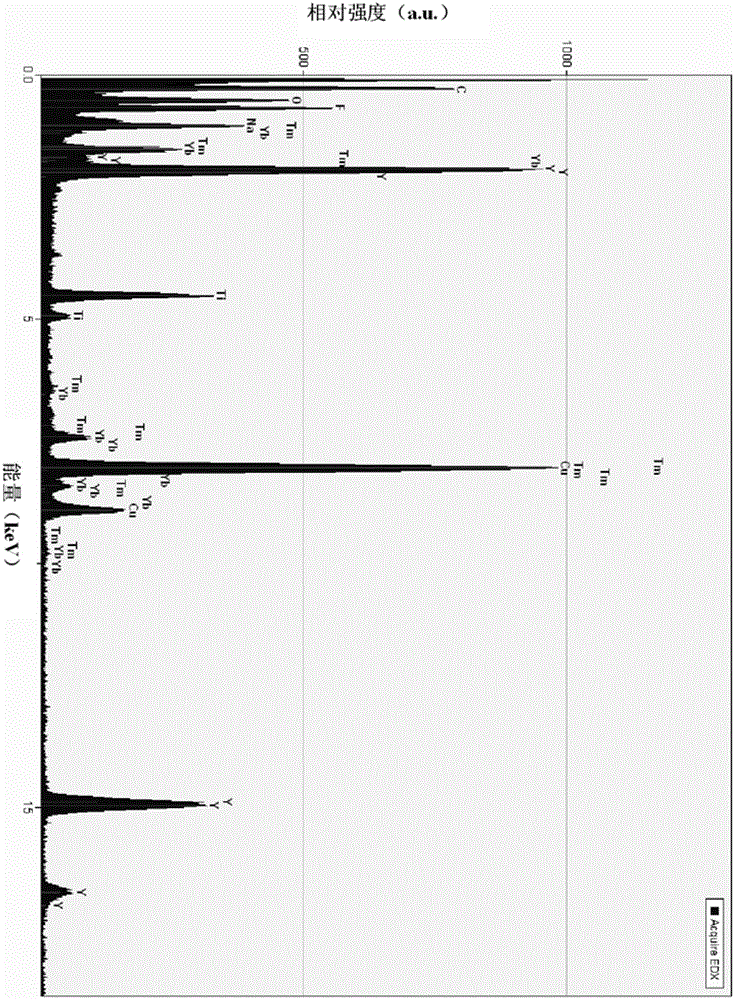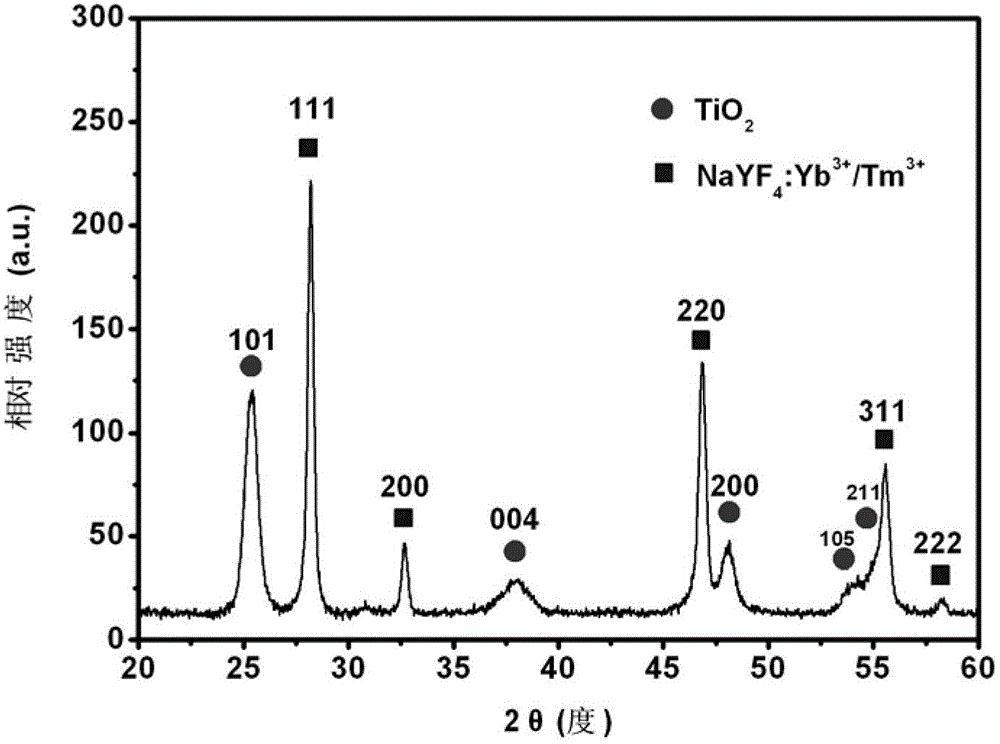Composite nano-particles used in inorganic photodynamic therapy, and preparation method thereof
A composite nanoparticle, photodynamic therapy technology, applied in medical preparations containing active ingredients, wave energy or particle radiation treatment materials, drug combinations, etc. Tissue damage and other problems, to avoid weak UV light penetration, low biological toxicity, and appropriate particle size
- Summary
- Abstract
- Description
- Claims
- Application Information
AI Technical Summary
Problems solved by technology
Method used
Image
Examples
Embodiment 1
[0038] (1) Firstly, upconversion luminescent nanoparticles were prepared, and Y(NO 3 ) 3 , Yb(NO 3 ) 3 and Tm(NO 3 ) 3 The aqueous solution is mixed and stirred according to the molar ratio of 8.9:1.0:0.1, and then 12.5 mL of an aqueous solution of 0.1 M sodium citrate and 30 mL of an aqueous solution of 0.5 M sodium fluoride are sequentially added thereto as a modifier and a complexing agent, and Stir for 1 hour. Put the mixed solution into the reaction kettle, and conduct a hydrothermal reaction at 120°C for 2 hours to obtain NaYF 4 :Yb 3+ / Tm 3+ Nanoparticles, the product is cleaned and purified.
[0039] (2) The prepared NaYF 4 :Yb 3+ / Tm 3+ Re-disperse 100mg of nanoparticles into 50mL of ethanol / water mixed solution, ultrasonically disperse, control the ratio of alcohol to water to 4:1, then add 1mL of 0.1M tetrabutyl titanate ethanol solution to it, and fully stir at 70°C 1 hour;
[0040] (3) After the reaction is completed, the product is cleaned and purifi...
Embodiment 2
[0048] (1) Firstly, upconversion luminescent nanoparticles were prepared, and Y(NO 3 ) 3 , Yb(NO 3 ) 3 and Tm(NO 3 ) 3 The aqueous solution is mixed and stirred according to the molar ratio of 7.8:2.0:0.2, and then 10mL of 0.1M sodium citrate aqueous solution and 0.5M sodium fluoride aqueous solution 25mL are sequentially added thereto as modifier and complexing agent, and stirred 1 hour. Put the mixed solution into the reaction vessel, and conduct a hydrothermal reaction at 180°C for 2 hours to obtain NaYF 4 :Yb 3+ / Tm 3+ Nanoparticles, the product is cleaned and purified.
[0049] (2) The prepared NaYF 4 :Yb 3+ / Tm 3+ Re-disperse 100mg of nanoparticles into 50mL aqueous solution, ultrasonically disperse, then add 5mL of 0.1M titanium tetrachloride aqueous solution to it, and fully stir for 1 hour in an ice bath;
[0050] (3) Add NH dropwise to the above reaction vessel 3 ·H 2 O solution, adjust its pH value between 7.0-8.0, and fully stir for more than 2 hours;...
Embodiment 3
[0054] (1) Firstly, upconversion luminescent nanoparticles were prepared, and Y(NO 3 ) 3 , Yb(NO 3 ) 3 and Tm(NO 3 ) 3 The aqueous solution is mixed and stirred according to the molar ratio of 8.9:1.0:0.1, and then 15 mL of an aqueous solution of 0.1 M sodium citrate and 30 mL of an aqueous solution of 0.5 M sodium fluoride are sequentially added thereto as modifiers and complexing agents, and stirred 1 hour. Put the mixed solution into the reaction kettle, and conduct a hydrothermal reaction at 120°C for 6 hours to obtain NaYF 4 :Yb 3+ / Tm 3+ Nanoparticles, the product is cleaned and purified.
[0055] (2) The prepared NaYF 4 :Yb 3+ / Tm 3+ Nanoparticles 100mg are redispersed in the mixed solution of 15mL of oleic acid / oleylamine / ethanol, the volume ratio of oleic acid / oleylamine / ethanol is 3:2:10, then add the tetrabutyl titanate of 0.1M wherein 10mL ethanol solution, after fully stirring, carry out hydrothermal reaction at 180°C for 12 hours;
[0056] (3) After ...
PUM
| Property | Measurement | Unit |
|---|---|---|
| Size | aaaaa | aaaaa |
Abstract
Description
Claims
Application Information
 Login to View More
Login to View More - R&D
- Intellectual Property
- Life Sciences
- Materials
- Tech Scout
- Unparalleled Data Quality
- Higher Quality Content
- 60% Fewer Hallucinations
Browse by: Latest US Patents, China's latest patents, Technical Efficacy Thesaurus, Application Domain, Technology Topic, Popular Technical Reports.
© 2025 PatSnap. All rights reserved.Legal|Privacy policy|Modern Slavery Act Transparency Statement|Sitemap|About US| Contact US: help@patsnap.com



